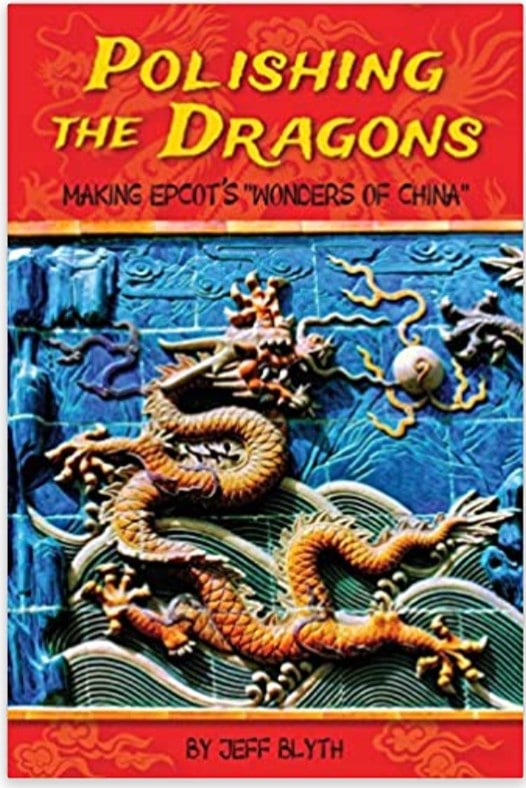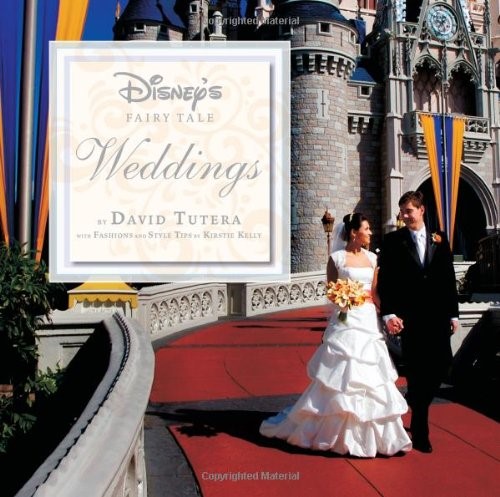Category — A Friday Visit with Jim Korkis
A Friday Visit with Jim Korkis: Donald Duck in Florida
Welcome back to Fridays with Jim Korkis! Jim, the dean of Disney historians, writes about Walt Disney World history every Friday on yourfirstvisit.net.
DONALD DUCK IN FLORIDA
By Jim Korkis
Donald Duck visited the Sunshine State nearly two decades before Walt Disney World sprang out of central Florida swamps in 1971. Donald and his nephews were typical tourists in the animated cartoon short Don’s Fountain of Youth, released on May 30, 1953.
They travel along US Highway 1, and come upon the site of an old Spanish fort, dated 1571. It would appear that background artist Art Riley drew inspiration from both Castillo de San Marcos and the Fort Mantanzas National Monument located in Saint Augustine. The Castillo de San Marcos was constructed during the latter decades of the 17th century; Fort Mantanzas was built in the mid-18th century.
Of course, they have misadventures with a Florida alligator and Donald mistakenly thinking he has discovered Ponce De Leon’s fabled Fountain of Youth.
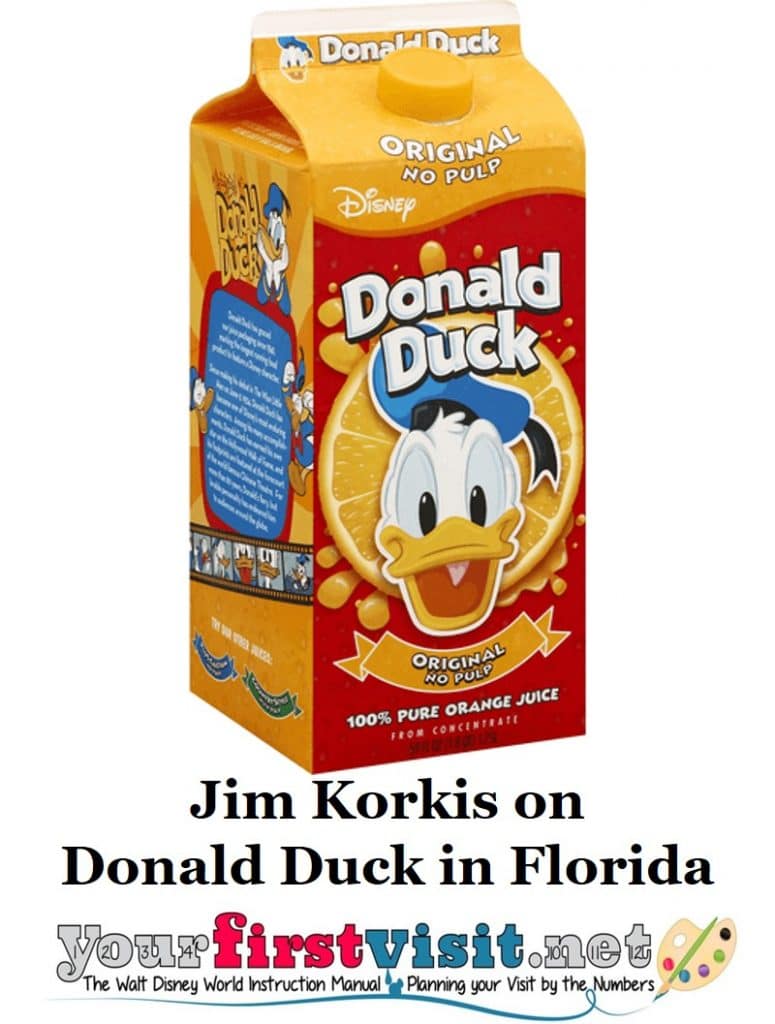
Citrus World’s (now “Florida’s Natural Growers”) large water tower had the face of Donald Duck on it until 1998, when the company went through a re-branding with the new name, and at one time there was a full sized statue of Donald Duck in the lobby of the building and a huge billboard of Donald on the top of the building as well.
During World War II with rationing, many Disney licensees couldn’t get material to produce items. The licensing of food products was one way Disney merchandising representative Kay Kamen kept money flowing into the Disney studio coffers: peanut butter, jam, popcorn, mustard, chocolate syrup and sodas were all produced featuring Donald Duck.
Donald Duck Orange Juice is the longest surviving Disney food and beverage licensee, starting in 1941. The company also produced Donald Duck Grapefruit Juice.
Donald Duck has no direct relation to food products–or orange juice for that matter–other than the fact that during World War II his popularity soared more than Mickey Mouse, and he was beloved by audiences around the world. Manufacturers just felt that his image would help sell a product.
During the 1940s, sixty boxcars of fresh citrus fruit a day were being processed by Florida Citrus Canners Cooperative at Lake Wales. About forty of those boxcars of fruit were converted into 8,000 gallons of orange concentrate destined exclusively for the United States armed forces and their allies.
Total volume of concentrate reached 800,000 gallons. When reconstituted on the basis of seven gallons of water to a gallon of concentrate, it produced 6.4 million gallons of juice. All were shipped under the Donald Duck brand. Concentrate required only about one-eighth of the space that fresh fruit required.
Donald Duck brand orange juice is still popular after nearly eighty years. After Walt died, the Walt Disney Company contacted the company and accused them of not having a proper license to use the character name and image because they could not find any paperwork.
The company was able to produce an old, yellowed document clearly showing that Walt and Roy had given them the rights with no cessation as long as they maintained the quality of the product.
Why isn’t Donald Duck Orange Juice sold on Walt Disney World property? Well, Coca-Cola is a huge sponsor of Disneyland and Walt Disney World, so you will only find its Minute Maid Orange Juice. Donald Duck Orange Juice is licensed to Florida’s Natural brand.
* * * * *
Thanks, Jim! And come back next Friday for more from Jim Korkis!
In the meantime, check out his books, including his new books Vault of Walt Volume 9: Halloween Edition, and Hidden Treasures of the Disney Cruise Line.
Follow yourfirstvisit.net on Facebook or Twitter or Pinterest!!
January 15, 2021 No Comments
A Friday Visit with Jim Korkis: Disney’s Art of Animation Resort
Welcome back to Fridays with Jim Korkis! Jim, the dean of Disney historians, writes about Walt Disney World history every Friday on yourfirstvisit.net.
THE ORIGIN OF DISNEY’S ART OF ANIMATION RESORT
By Jim Korkis
Construction work was conducted on the planned two halves of Pop Century Resort (Classic Years and Legendary Years) from 1999 through 2001. The resort in total was meant to celebrate each decade of the 20th Century just as the new Millennium was about to begin.
A bridge originally named the Generation Gap Bridge was constructed across Hourglass Lake to connect both halves of Pop Century and make them accessible to each other.
However, the terrorism attack on September 11th resulted in a significant drop in tourism, so Disney stopped work on the entire because of lack of demand.
When work finally resumed on Pop Century, the economy was rebounding slowly and there was no initial need for all 5,760 rooms from both halves, which meant that only The Classic Years was initially completed and opened in 2003. Disney kept announcing the other half, The Legendary Years, would be completed since some building shells and infrastructure were in place.
In January 2010 Disney announced the resort would be re-themed into Disney’s Art of Animation Resort with construction beginning that summer. In addition, because of the success of the family suites at the All Star Music, seven new buildings (all except the three devoted to The Little Mermaid, originally intended to represent the 1940s decade, and almost completed) would be built as family suites.
The phrase “The Art of Animation” has a long heritage. In 1958, Walt Disney put together three traveling animation exhibits depicting the history and process of animation to promote the film Sleeping Beauty (1959). The exhibit was called “The Art of Animation: A Walt Disney Retrospective” and one was in Disneyland’s Tomorrowland until September 1966.
In addition, Walt had author Bob Thomas write a book about the same topic called The Art of Animation that was released in 1958 and later updated in 1991 to promote Beauty and the Beast (1991) and in 1997 to promote Hercules (1997).
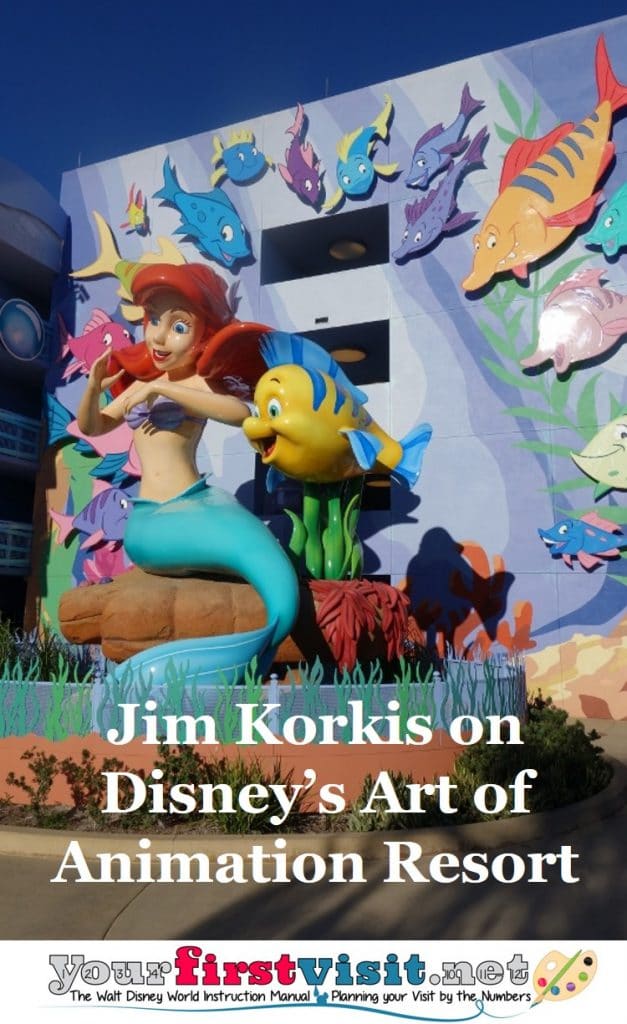
Research showed that modern families were more familiar and emotionally connected with films released during the previous twenty-five years especially those produced by Pixar rather than the original classic Disney Studio ones created by Walt Disney. In addition, selection was made of films prominently represented in the parks by attractions, shows, merchandise sales and more.
So the following films were selected: Finding Nemo (2003), Cars (2006), The Lion King (1994) and The Little Mermaid (1989).
The outside of each four-story rectangular building at the resort is covered in characters, backgrounds and icons from the respective films. There are more three-dimensional figures than at any other Disney resort, and they offer multiple photo opportunities like the thirty-five foot tall sculpture of King Triton done by Joni Van Buren from the film The Little Mermaid. In total, there are approximately 2,500 figures at the entire resort.
“These themes have both compelling storylines and vivid visuals which will come together to create a truly memorable, immersive resort experience,” said Eric Jacobson, Senior Vice President of Walt Disney Imagineering.
“With more multi-generational families vacationing together, guests are looking for places where they can play together and stay together. This resort was designed with the needs of families in mind, as we continue the Disney tradition of providing a great guest experience for every taste and budget.”
* * * * *
Thanks, Jim!
Much more on Disney’s Art of Animation Resort begins here.
Come back next Friday for more from Jim Korkis! In the meantime, check out his books, including his new books Vault of Walt Volume 9: Halloween Edition, and Hidden Treasures of the Disney Cruise Line.
Follow yourfirstvisit.net on Facebook or Twitter or Pinterest!!
January 8, 2021 No Comments
A Friday Visit with Jim Korkis: Polishing the Dragons
Welcome back to Fridays with Jim Korkis! Jim, the dean of Disney historians, writes about Walt Disney World history every Friday on yourfirstvisit.net.
YOUR PERSONAL DISNEY LIBRARY (36)
By Jim Korkis
- Polishing the Dragons by Jeff Blyth
The title of Polishing the Dragons refers to making sure that every detail, no matter how small or seemingly inconsequential, looked marvelous when filming the 360 degree film Wonders of China: Land of Beauty, Land of Time for the China pavilion at Epcot.
At nearly 250 pages, Polishing the Dragons by Jeff Blyth, the director of not only this film but also several other Circle-Vision films for Disney, is a fascinating glimpse into the challenges of making this film that played for twenty years at Epcot as well as ten years at Disneyland.
At the time the film debuted on opening day at Epcot in 1982, people realized how amazing it was to catch such an overwhelming glimpse of the beauty of China, since the Disney film crew were the first non-Chinese outsiders to be allowed to film certain sites, and had to carefully maneuver through government restrictions.
In 2003, the film was replaced by a newer film entitled Reflections of China that incorporated some of the footage from the original film, and was also directed by Blyth.
Birnbaum’s Walt Disney World: The Official Vacation Guide stated about the Wonders of China, “Every step of the way, the film crews were besieged by curious Chinese, even in empty Mongolia. For the Huangshan Mountain sequence, which lasts only seconds, the crew and about three dozen hired laborers had to carry the 600-pound camera uphill for nearly a mile.
“The Chinese government would not permit Disney cameramen to shoot aerial footage in some areas, so Chinese crews were sent aloft to record the required scenes, first on videotape and later—after approval from the Disney director in charge of the project—on film.”
The book is very well put together, with a distinctive kinetic “feel” to the cover and interior pages. The conversational tone of the text is very appealing and gives an intimate insight into the mind of the filmmaker and why certain decisions were made.
The book contains 400 full color photographs from the author’s personal collection. The book is an expansion of a personal journal that Blyth kept for decades, which is an exciting revelation since it could mean future books chronicling some of Blyth’s other work for Disney.
Blyth’s work on Wonders of China led to more work for Disney, including The Eternal Sea (at Tokyo Disneyland), American Journeys (at Disneyland, the Magic Kingdom, and Tokyo Disneyland), and Portraits of Canada for EXPO 86 (also EPCOT).
Blyth directed the 1989 feature film Cheetah, a G-rated family adventure filmed on location in Kenya for Disney Studios, executive produced by Roy E. Disney.
He also directed the most ambitious Circle-Vision production ever made, From Time to Time, a premiere opening day attraction at EuroDisneyland (later Disneyland Paris). This film, with a few revisions, also played as The Timekeeper at Tokyo Disneyland and the Magic Kingdom.
I admit that I was a little hesitant that I might not enjoy a book just dedicated to a film that disappeared from Epcot years ago, but I found it fascinating once I started reading, because it comes across as a very personal journey with both amusing and frightening anecdotes, like one of the crew falling into Qianhai Lake, one of the most polluted but historic lakes in China. Obviously, the information about this film will never appear elsewhere or in this great detail.
For fans of original Epcot, Circle-Vision films, or China itself during a particular period of time, this book is definitely a “must have”. I still recommend it for others as well to add to their personal Disney libraries.
* * * * *
Thanks, Jim! and come back next Friday for more from Jim Korkis!
In the meantime, check out his books, including his two new books, Vault of Walt Volume 9: Halloween Edition, and Hidden Treasures of the Disney Cruise Line.
Follow yourfirstvisit.net on Facebook or Twitter or Pinterest!!
January 1, 2021 No Comments
A Friday Visit with Jim Korkis: The Art of Disney’s Riviera Resort
Welcome back to Fridays with Jim Korkis! Jim, the dean of Disney historians, writes about Walt Disney World history every Friday on yourfirstvisit.net.
THE ART OF DISNEY’S RIVIERA RESORT
By Jim Korkis
Disney resort hotels are renowned for their attention to artistic details and Disney’s Riviera Resort provides an opportunity to showcase the European influences of Disney heritage.
“The approach was to take the inspiration of a classical resort of a grand era along the European coast in a uniquely Disney experience. We do that by creating a level of casual elegance as part of the experience,” said Imagineer Dean Huspen.
“While the color palette itself is classical, the pops of colors on the awning and shutters and the area development and even the way we incorporate little discoveries in design features into the ornamental metal work and the railings became that approach.”
According to Imagineer Missy Renard, “The inspiration came from the renowned art heritage of the Riviera region itself where there was a prolific amount of work that came from the late 19th century and 20th century masters. What we’ve done is taken our Disney characters and icons and work them into these series of paintings and different kinds of art that reflect the subject, brush strokes and technique of what the artists were studying.”
The goal was to capture a European style and sensibility of art with a Disney twist. In addition, there is a variety of Riviera-themed artwork around the resort that doesn’t have anything at all to do with Disney.
As Disney has stated, “During the early-20th-century, artists along the Riviera were exploring ways to make still life objects come to life on a flat canvas. Artists would first break the objects into individual shapes and forms then accentuate each object with strong outlines.”
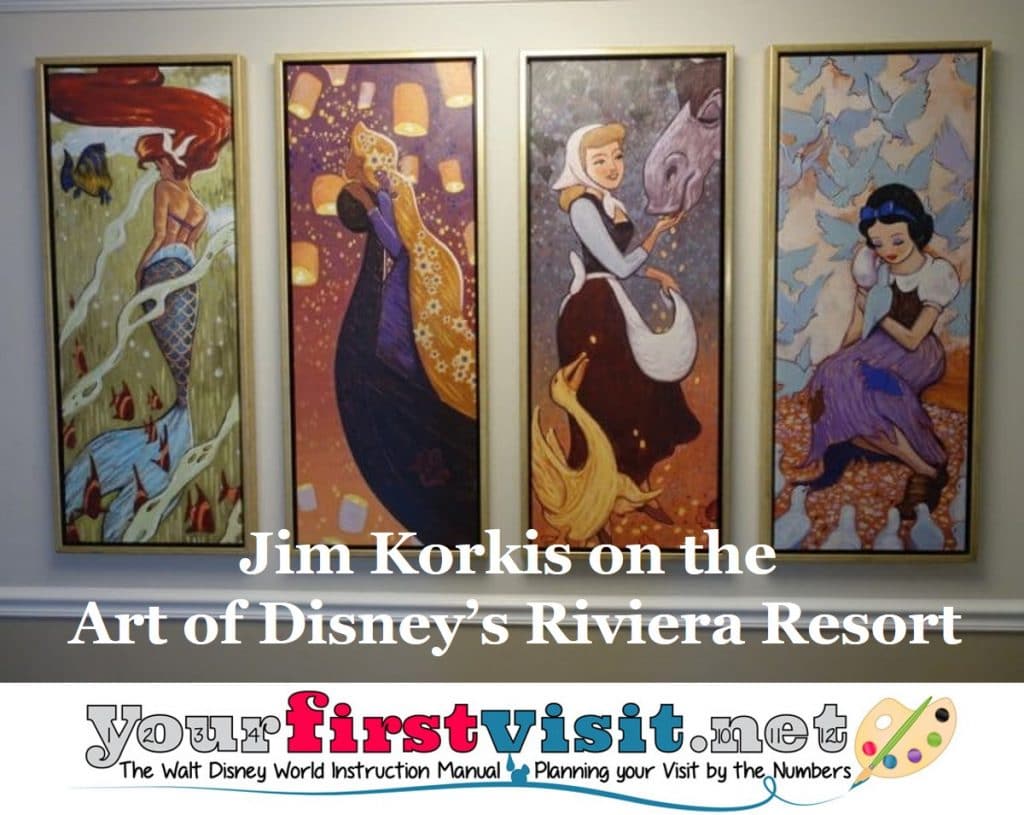
The dramatic hues of sunset inspired Disney artists in painting Rapunzel and Pascal as they watch the glowing lanterns illuminate the evening sky, creating a delightful pattern of shape and color in the painting called “Girl With Lanterns”.
The S’il Vous Play interactive children’s water play area draws inspiration from the grand public fountains seen throughout Europe with its patina and limestone-inspired design.
Another inspiration for it was the “Dance of the Hours” segment from the animated feature Fantasia (1940). The area celebrates music, art, dance and storytelling by featuring whimsical animals from the film frolicking and playing in the water. An elephant filling a dump bucket with his trunk, hippos and ostriches dancing and playing, as well as hippos splashing water into decorative bowls and basins are meant to bring a smile to guests’ faces.
A dedicated Disney Skyliner station leads to an archway with two mosaic murals made from one million hand-cut tiles. One mural is the lantern scene from Tangled (2010) and the other shows pixie dust circling the Tower of London and arching over to the Neverland Lagoon where the golden Jolly Roger pirate ship takes flight from Peter Pan (1953). Both reference flight to tie-in with the Skyliner and both feature European stories.
Artwork referencing Peter Pan is scattered throughout the resort including in the one bedroom villas a painting inspired by Mary Blair’s concept art for that 1953 animated film with the Darling children flying out of their bedroom window, and in the hallways a painting of Mrs. Darling reading to her children and Nana the dog.
In the deluxe studio by the bed, there is an homage to a vintage French poster with Mademoiselle Minnie and for sharp-eyed guests in another painting guests can see the red Lightning McQueen racing along a bridge over the sea.
Of course, there are many Hidden Mickeys as well. The hallway carpeting is in gold, blue, and white to evoke a European elegance and hidden in the filigree pattern is the head of Minnie Mouse.
Rich colors, elegant metallics and metals, and playful artwork and décor once again show the care and skill of including artistic influences into a Disney resort hotel.
* * * * *
Thanks, Jim!
Much more on Disney’s Riviera Resort begins here, with art from the resort particularly featured here.
Come back next Friday for more from Jim Korkis! In the meantime, check out his books, including his new Halloween-appropriate Vault of Walt Volume 9: Halloween Edition, and his other new book, Hidden Treasures of the Disney Cruise Line.
Follow yourfirstvisit.net on Facebook or Twitter or Pinterest!!
December 28, 2020 No Comments
A Friday Visit with Jim Korkis: Disney’s Fairy Tale Weddings
Welcome back to Fridays with Jim Korkis! Jim, the dean of Disney historians, writes about Walt Disney World history every Friday on yourfirstvisit.net.
YOUR PERSONAL DISNEY LIBRARY (35)
By Jim Korkis
- Disney’s Fairy Tale Weddings by David Tutera
There are many different types of magic that can take place at Walt Disney World. For some it is the site of their first date or kiss. For others, it is where they proposed. Increasingly, it is the place where people get married.
Disney fans have always wanted to get married at a Disney park. I recall even in the late 1980s friends doing “guerilla weddings” by hiding the appropriate clothes like a tux or a wedding dress in the lockers and having a handful of guests attend a “quickie ceremony” at a pre-arranged time and location before Disney security was alerted.
The Walt Disney Company saw this desire as an opportunity to increase revenue (and to control the situation) by officially hosting weddings in September 1991. Disney’s Fairy Tale Weddings & Honeymoon division was started in 1992. It is part of the Disney Parks Experiences and Products division.
The Disney Wedding Pavilion opened in 1995 near the Grand Floridian Resort & Spa with a wedding for the first episode of the television show Weddings of a Lifetime. In 2017, Freeform and Disney+ offered the Disney’s Fairy Tale Weddings documentary television series profiling couples’ marriages at the parks.
Disney’s Wedding Pavilion is an intimate setting that hosts up to 250 people and is only accessible by the footbridge from the Grand Floridian Resort & Spa. It features a view of Cinderella’s Castle at the Magic Kingdom.
However, the Wedding Pavilion is not the only location to host WDW weddings. Disney has used the World Showcase pavilions at Epcot as well as locations like the BoardWalk Resort, Yacht Club Resort, and Polynesian Village Resort.
A wedding can cost from as little as $4,000 for just four guests at a small resort location to well over $12,000. For Magic Kingdom after hours, the minimum expenditure is $50,000.
And, of course, those are all just minimum prices. Including just one Disney character performer for thirty minutes can cost an additional $1,500. Including Cinderella’s Glass Coach can add an additional $3,500.
Disney’s Fairy Tale Weddings avoids all those discussions of hard costs, not only because they keep increasing, but not to spoil the magic. It focuses on invitations, food and beverage, the wedding cake, lighting, decoration, fashion, flowers and other similar topics for upscale weddings.
Disney’s Fairy Tale Weddings is written by David Tutera, a notable celebrity event planner whose portfolio includes weddings, with additional contributions by Kirstie Kelly, a bridal gown designer who works with Disney Fairy Tale Weddings to create bridal gowns, bridesmaid dresses, flower girl fashions and accessories.
The information provided in Disney’s Fairy Tale Weddings is more for any type of upscale wedding rather than specifically focused on a wedding that might showcase a particular Disney movie, theme or characters. More recent information can be found at the Disney Fairy Tales Wedding website.
As with all Disney Editions books, Disney’s Fairy Tale Weddings is overflowing with beautiful full color photographs on every page. For me, I was disappointed that the text was not more Disney-centric. Moreover, a simple search on the internet will garner many more creative (and less expensive) ideas for a Disney-themed wedding.
However, the appeal of getting married at Walt Disney World is an idea that appeals to tens of thousands of hopeful couples every year, with two thousand or more actually doing it.
Since Disney’s Fairy Tale Weddings lacks any historical data and information specific on creating a Disney themed wedding, I would have difficulty recommending including this book in your collection unless the topic is a particular fascination of yours.
* * * * *
Thanks, Jim! and come back next Friday for more from Jim Korkis!
In the meantime, check out his books, including his new Halloween-appropriate Vault of Walt Volume 9: Halloween Edition, and his other new book, Hidden Treasures of the Disney Cruise Line.
Follow yourfirstvisit.net on Facebook or Twitter or Pinterest!!
December 18, 2020 No Comments
A Friday Visit with Jim Korkis: The Days of Christmas Shop
Welcome back to Fridays with Jim Korkis! Jim, the dean of Disney historians, writes about Walt Disney World history every Friday on yourfirstvisit.net.
THE DAYS OF CHRISTMAS AT DISNEY SPRINGS
By Jim Korkis
Lake Buena Vista Village opened on March 22, 1975. This shopping venue evolved into Walt Disney World Village starting in 1977. In 1989, it underwent another name change and became the Disney Village Marketplace.
The name was changed yet again in 1996 to Downtown Disney Marketplace before being extensively remodeled into Disney Springs in 2015.
The original shopping venue had a store called Anniversary Room that sold china, silver and giftware. It became the Christmas Chalet roughly around 1986, and that store moved over the years to three other locations before finally settling where previously the Team Mickey Athletic Club was operating and being renamed the Days of Christmas in 1996.
The festive store celebrates Christmas, in particular a Disney themed Christmas, 365 days a year, with a variety of merchandise from a Santa hat with Mickey Mouse ears to ornaments, stockings, lights, cards, plush dolls, figurines, collectible plates, tree skirts and more. Many items can be personalized for a small fee and the staff can personalize more than 60,000 individual items in a year.
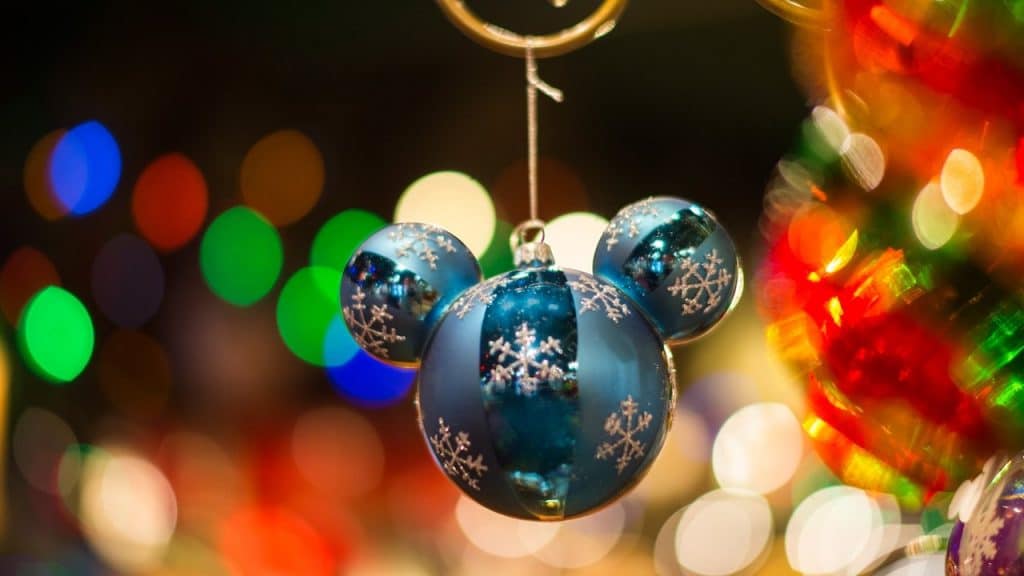
(c) Disney
At 6,000 square feet Days of Christmas is the largest Christmas shop on Disney property. Background music of holiday tunes fills the air along with the scents of cinnamon and winter herbs. While the store is especially busy during the holiday season, it still is very alive during the rest of the year with guests often purchasing items to save for Christmas decorating. In addition there are Hanukkah, Nightmare Before Christmas and Frozen items for sale as well.
The other two Walt Disney World Christmas stores are Ye Olde Christmas Shoppe in Liberty Square (opened February 1996) at Magic Kingdom and It’s A Wonderful Shop (opened in June 1992), with a name referencing the favorite Christmas film It’s a Wonderful Life, at Disney’s Hollywood Studios near the Muppet Stage 1 store.
The name of the Disney Springs shop comes from the famous song The Twelve Days of Christmas. Throughout the location there are twelve scrolls each with one verse and with matching scenes. Some guests love going through and finding them all.
Here are the verses of the Disney adaptation of the classic poem:
- On the first day of Christmas, my true love gave to me, Mickey in a yule tree.
- On the second day of Christmas my true love gave to me, Two Tweedledees.
- On the third day of Christmas, my true love gave to me, Three Little Pigs.
- On the fourth day of Christmas my true love gave to me, Four chiming bells.
- On the fifth day of Christmas, my true love gave to me, Five Goofy Things.
- On the sixth day of Christmas, my true love gave to me, Six Ducks a-playing.
- On the seventh day of Christmas, my true love gave to me, Seven Dwarfs a-mining.
- On the eighth day of Christmas, my true love gave to me, Eight Toys a-spinning.
- On the ninth day of Christmas, my true love gave to me, Nine Genies flying.
- On the tenth day of Christmas, my true love gave to me, Ten Minnies a-dancing.
- On the eleventh day of Christmas, my true love gave to me, Eleven puppies panting.
- On the twelfth day of Christmas, my true love gave to me Twelve Fairies a-flitting.
For years, Days of Christmas was home to a very Hidden Mickey, because it was covered up by a wreath that has since been removed, so people were unable to find it. You might want to look at an area with dark grainy faux wood or ask a cast member working there to give you a hint.
* * * * *
Thanks, Jim! and come back next Friday for more from Jim Korkis!
In the meantime, check out his books, including his new Halloween-appropriate Vault of Walt Volume 9: Halloween Edition, and his other new book, Hidden Treasures of the Disney Cruise Line.
Follow yourfirstvisit.net on Facebook or Twitter or Pinterest!!
December 11, 2020 No Comments


